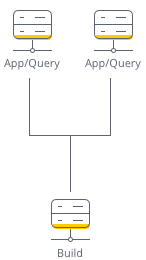Supported Deployments Overview
Previous Steps
Sisense supports several different multi-node deployment models.
The model you should choose is determined by these three parameters:
- Redundancy: Which components require redundancy?
- Concurrency: How many users do you need to support?
- Resources: How many servers can you add and maintain to your configuration?
The differences between each model are the amount of redundancy they provide, how much scale they support, and how many resources you need to implement them.
| Model 1 | Model 2 | Model 3 | Model 4 | |
|---|---|---|---|---|
| Enhanced Security | ✓ | ✓ | ✓ | |
| High availability & Redundancy | ✓ | ✓ | ||
| Scale Performance | ✓ | ✓ | ✓ | ✓ |
| Dedicated Hardware | ✓ | ✓ | ||
| Scale as You Grow | ✓ | ✓ |
The advantages of each model are described in more detail below.
Model 1

In Model 1, Sisense is vertically scaled out, which means that the application node is separated from the query and build node. This deployment provides the following benefits:
- Enhanced Security: When the application node and query/build nodes are separated, Viewers who interact with just the application node, are less vulnerable
- Scale Performance: Vertical scaling enables more users to query data while the build node can continue to build ElastiCube models
- Dedicated Servers per Task: Support greater concurrency by dedicating one machine to supporting Sisense, while another machine supports queries and building ElastiCube models
For more information, see Model 1: 1 Application Node, 1 Query Node/Build Node.
Model 2

In Model 2, Sisense is vertically scaled out with the application, query, and build node separated. This deployment provides the following benefits:
- Enhanced Security: When the application node, query, and build nodes are separated, Viewers who interact with just the application node, are less vulnerable
- Scale Performance: Vertical scaling enables more users to query data while the build node can continue to build ElastiCube models
- Dedicated Servers per Task: Support greater concurrency by dedicating one machine to supporting Sisense, while another machine supports queries and building ElastiCube models
For more information, see Model 2: 1 Application Node, 1 Query Node, 1 Build Node.
Model 3

In Model 3, Sisense is horizontally scaled out with the application/query nodes replicated. This deployment provides the following benefits:
- High Availability: Multiple application/query nodes ensures that if a single node fails, performance will not be affected and your Viewers won't experience any downtime
- Scale Performance: Horizontal scaling enables more users to query data and build models at the same time
- Dedicated Servers per Task: Support greater concurrency by dedicating one machine to supporting Sisense, while another machine supports queries and building ElastiCube models
- Scales as You Grow: Add additional application/query nodes as needed
For more information, see Model 3: 2 Application/Query Nodes and 1 Build Node.
Model 4

In Model 4, Sisense is horizontally scaled out with the application and query nodes replicated. This deployment provides the following benefits:
- High Availability: Multiple application and query nodes that have been replicated mean that if a single-server fails, your Viewers will not affect performance or lead to downtime
- Scale Performance: Horizontal scaling enables more users to query data and build models at the same time
- Dedicated Servers per Task: Support greater concurrency and redundancy by dedicating multiple machines to supporting Sisense, while other machines support queries and building ElastiCube models
- Scales as You Grow: Add additional application/query nodes as needed
Note:
If you want to implement a topology that is not supported by Sisense, contact your CSM.
Next Steps
- Installing the Multi-Node Deployment Wizard
- Distributing ElastiCube Builds to Query Nodes
- Setting Up ElastiCube Sets
- Securing the Message Broker's Communication
.r.